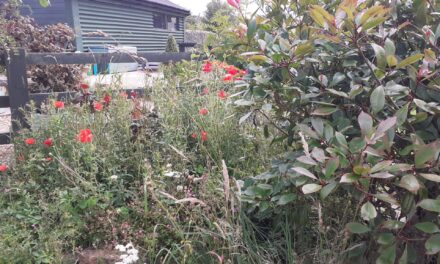Before moving to the Bury area, I had never considered the importance of community gardens. Now that I’m surrounded by a wealth of horticultural creations – all created by people with a desire to elevate their local space – I love them. There is a lot to be said for somewhere safe where people can just hang out and meet others without spending any money, especially for those who don’t have access to a garden.
While environmental stewardship is a concept more readily applied to indigenous peoples in remote areas like the Amazon than it is to Britain’s urban landscape, it’s still true that even the smallest space can pay dividends to the community. Though much of our land is officially owned, it can be looked after as local space, especially as many councils don’t have the budget to spend on pocket parks.
 One such example of how a disused green area can be transformed into something much more is Top Mill Park in Ramsbottom. It was created during COVID by residents, bringing an overgrown patch of council land into a beautiful park that people want to spend time in. Now it has bird boxes, flower beds, benches, greenhouses, artwork, a noticeboard, and free poo bags for dog walkers.
One such example of how a disused green area can be transformed into something much more is Top Mill Park in Ramsbottom. It was created during COVID by residents, bringing an overgrown patch of council land into a beautiful park that people want to spend time in. Now it has bird boxes, flower beds, benches, greenhouses, artwork, a noticeboard, and free poo bags for dog walkers.
On one side of Cross Bank Brook are the foundations of Top Mill where vegetables are now grown within its crumbling walls. There used to be several mills with lodges around the Shuttleworth area but many have fallen into the fields, without much attempt to preserve anything of them.
It seems to often be the case that working-class history is not revered in the same way as expensive manors which cost much more to repair and maintain. While a few mills remain in the North West as museums, or monuments to what they once were, many suffer from modern development, arson or slow decline. In this way, Top Mill bucks the trend, with the foundations allowed to stand as they are, enveloped by the protective parkland named after it.
The park’s decor changes with the seasons to celebrate events like the King’s coronation, Remembrance Day, and Halloween. In December, Father Christmas comes to visit, aided by whomever can be persuaded to don a costume. It’s not the only one in the area either, with land under bridges, next to railways, rivers and even areas of churchyards being transformed by people who truly care about where they live.
These places are also an ideal place to get close to semi-urban wildlife as many bird species will use nest boxes, including nuthatches, blue tits, great tits and dunnocks. They also provide flowers for birds and butterflies which struggle as the fields and hedgerows where they feed are depleted. Early one morning, I even saw deer in a community park. Fairy gardens, painted stones, flower tubs and bird feeders abound in the towns and villages around Bury, and that’s what makes living here so special because someone did that to give enjoyment to passers-by. 
Small-scale stewardship like this makes sense because people are much more likely to engage with the place they live, as well as understand its history. This is not to say that looking after green space is without its problems. Issues like anti-social behaviour, vandalism, illegal development, littering, and extreme weather events including storms and flooding all take their toll on community parks. It’s the downside that all these gardens face, as clearing up after others is the last thing that groups need given the amount of labour already involved.
While unlocking the potential in an unloved green space can undoubtedly be satisfying, much of the work is in the things that go unnoticed. It’s the jobs like weeding, picking up dog poo, leaves and litter as well as cutting the grass that would only be noticed if they weren’t done that take the time. Having said that, I know a 90-year-old man who tends to a community garden every day and I wonder if it is this purpose which makes him so spritely.
Even though the value of community gardens is hard to measure in pounds and pence, it certainly pays off for communities. In the chaos of Greater Manchester, pockets of green space offer the respite we need to find peace among the hustle and bustle, as well as important moments of connection with our neighbours.


 Words and images by Jennifer Sizeland
Words and images by Jennifer Sizeland





